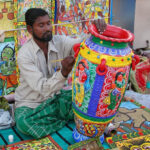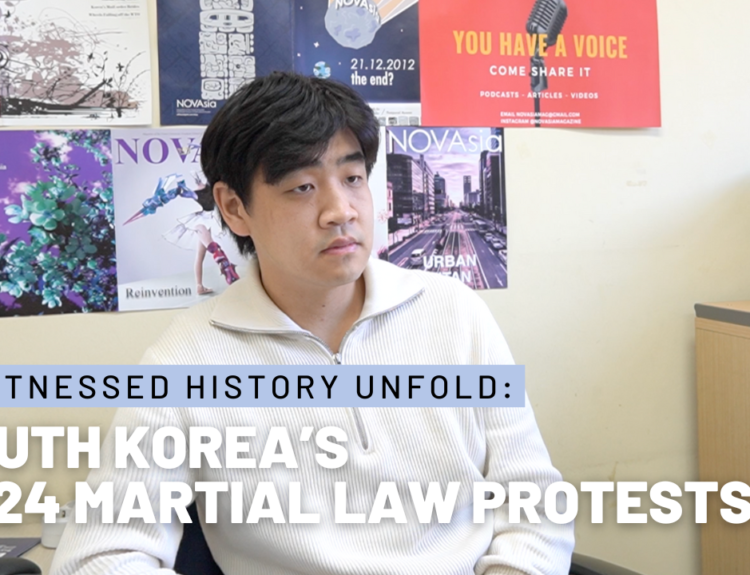“The apartment block was an architectural monument to a phallocentric world.” Source here
The contemporary Seoul cityscape, as well as other cities in South Korea, have their roots in gender-segregated space stemming from the 1960s to serve the newly birthed post-Korean War capitalist nation-building project. New power and social hierarchies were materialised through the physicality of architecture, bringing forth changes in gender roles, family dynamics, and middle class culture. External male socio-political public life contrasted with internal female private family life. Simultaneously, birth control technologies, international media infiltration, and the birth of the nuclear family emerged.
The rise of apartment blocks
South Korea was in ruins after the 1950-53 Korean War. Preceding the 1961 coupe d’état by Park Chung-hee (박정희), he was on a mission to charge the country forward, from a predominately agricultural nation to a modernised and industrialised one. This process had already started during the Japanese colonial (1910-1945) era from the 1920s onwards, however, the Korean War had left many towns and cities destroyed. In the 1960s, with the development of cities through factories and various industries, a huge influx of citizens migrating from the countryside to cities such as Seoul for work, put a large strain on housing needs. In 1966, Seoul had a population of 3.8 million people and 720,000 households, with only 360,000 homes available. Most of the existing houses were lined up side-by-side with tiled or thatched roofs. A solution was necessary.
Park Chung-hee brought on a fellow graduate of the Korea Military Academy, Kim Hyeon-ok (김현옥), as the Seoul Mayor in 1966. Nicknamed the “bulldozer,” Mayor Kim went onto bulldoze shanty towns, which were formed by those who had lost their homes during the Korean War as well as refugees from North Korea. He led major developments in Seoul, including road constructions and apartment projects. This Western apartment trend had already initially emerged into what is known to be the first apartment complex in Seoul called Eurim apartment (우림아파트) in Chungjeong-ro (층종로); a four-storey apartment complex designed by a Japanese architect named Toyoda in the 1930s. However, after 1966, Mayor Kim took apartment construction to another level.
In 1968, Geumhwa Apartments (금화아파트) were the start, followed in 1969 with 406 apartment blocks being constructed in Seoul, creating homes for 15,840 households. Major developments were started in Gangnam in the 1970s, the area south of Seoul’s city central Han River. In 1972 and 1973, the government enacted laws, which allowed them to provide financial support to the private sector. This spurned an increase in construction projects. Apartment blocks rose to ten to fifteen stories in the previously agricultural and empty land of Apgujeong and Jasmil in the Gangnam district. Now apartment blocks are synonymous with the cityscape of Seoul, with one third of its citizens living in near identical apartments row after row. They are the preferred choice by Seoulites, a trend that started in the 1970s as a symbol of affluent middle class life. They often include many convenient facilities either within the apartment complex itself or within easy reach close to the complex, such as shopping centres, childcare centres, and gyms.
“It is convenient,” said Kim Sung-jin, an employee at Dell who has lived in three different apartment buildings in the past 17 years. “Plus you have a security guard. There’s a parking space for you. There’s a school nearby.” From the 1960s, these apartment blocks would prove to be ideal for a new type of family.

1970s Hyundai apartments by Hyundai Engineering & Construction.
Source: History of Korean Apartments through the Hyundai Engineering & Construction Apartments.
The nuclear family is born
Prior to industrialisation it was common for three generations of family to live as an extended family under the same roof. In Living with Conflicting Subjectivities: Mother, Motherly Wife, & Sexy Woman in the transition from Colonial-Modern to Postmodern Korea, Cho Haejoang compares two notable generations of women; the mothers and their middle class daughters who married and resided in this new domain of the apartment block. The middle class mothers were born in the 1920s, came of age during the Japanese colonial period, and raised their families after the hardships of the 1945 liberation and Korean War. They were the rocks of a heavily disrupted society, and were also symbolically the mothers of the nation.
Their daughters were born in the 1940s, experienced the Korean War as children, but in contrast to the poverty of their mother’s generation, they started to raise their families during the start of the 1960s South Korean economic boom. The Park Chung-hee government was encouraging its people to move to the cities as part of the manpower necessary for rapid industrialisation. Simultaneously, they were promoting a new idea of family, minus the grandparents and too many children – a nuclear family consisting of the husband, wife and through the promotion of family planning, the ideal of two children.
The emphasis of the woman as ‘mother’ within a large family household shifted to that of her being the dutiful modern wife within a new urban nuclear home setting. This was a concept, which had been started by the early modernists in the colonial era (1910-1945), with girls and women being educated to be “helpmates” to their husbands – as part of the nation building plan. These ‘modern wives’ had been educated with the latest and the best methods on family budgeting, hygiene, childrearing, and domestic chores.
In contrast to women, based on the idealogy of traditional patriarchal Confucianism, men were educated to stay away from domestic work and to work away from the home. This principle was carried over into the industrialisation of the 1960s and 1970s, with men expected to be the chief income earner of the household. Combined with the mandatory two plus years of military service that all able-bodied South Korean men had to undertake, there was a reinforcement of authoritarian patriarchal manliness. This masculine identity of being immersed in to the external public spheres of business, society, and risk was a given, extended from ancient tradition in to capitalistic modernity.
Birth control technologies for the nuclear family
As the population was rising, the Park Chung-hee’s government incorporated birth control technologies as part of a broader plan for national growth. By encouraging couples to have less children, it would reduce the strain on rural health care facilities, and additional revenue could be invested in to other areas of this nation in the flux of modernisation. One of the key figures involved was Dr. Yang Jae-mo (양재모), who organised the research centre of Population and Family Planning. He became the leader of one of the most successful family planning programs in the developing world, which was implemented nationwide by 1968.

1965 poster by the Planned Parenthood Federation of Korea (PPFK) shows a woman holding a Lippes Loop contraceptive device – first widely distributed in South Korea from 1964. The caption reads: “have the proper number of children and raise them well!” Source: (Let’s Have the Proper Number of Children and Raise Them Well!): Family Planning and Nation-Building in South Korea, 1961–1968.

Early 1970s advertisement for oral contraceptives in a ‘Happy Home’ (가정의 벗) edition – “a PPFK publication which began distribution in 1968 along with the introduction of Mothers’ Clubs.” Source: (Let’s Have the Proper Number of Children and Raise Them Well!): Family Planning and Nation-Building in South Korea, 1961–1968.

Early 1970s advertisement for oral contraceptives in a ‘Happy Home’ (가정의 벗) edition – “a PPFK publication which began distribution in 1968 along with the introduction of Mothers’ Clubs.” Source: (Let’s Have the Proper Number of Children and Raise Them Well!): Family Planning and Nation-Building in South Korea, 1961–1968.
Housewifization
As the masses continued to flock from the countryside to the cities for work in the 1960s and 70s, the architectural landscape reflected this. It was a burgeoning era for middle class men to start white collar careers. Even though gender rights and norms have evolved since then, 2022 still rests on the bedrock of a new world that had arisen in that era of transformation.
As office buildings started to spring up on freshly paved land, so did the diversification of new industries – from the light industries of clothing and wigs, to the heavy industries of steel and car manufacturing. In came a multitude of employment opportunities for both the working and middle classes. After the Korean War, women needed to work due to a low household income, because men were disabled or wounded. In contrast to this, this new era of modernisation brought in new economical opportunities. The government and accompanying media promoted the idea of a new middle class ideal; the hardworking bread winner husband/father and next to him, his faithful housewife wife/mother. Both resided in a brand-new, clean, modern apartment in downtown Seoul, with two children in tow. The modern city housewife was born.
She took care of the home through housework and the rearing of children. Her focus on the role of wife extended to learning and knowing about the best directions for their childrens’ education and future marriage prospects. Each month the husband handed over his paycheck to the wife. Also working as the family accountant, she decided on where to spend the money, how much to save and invest, and how much allowance the husband should receive.
Even though these white collar males were generally earning well enough for their wives not needing to work, and their income came from official and formal means, the wives were known to invest in an informal market economy, which also helped propel the national market economy.
5 types of housewives
In Living with Conflicting Subjectivities: Mother, Motherly Wife, & Sexy Woman in the transition from Colonial-Modern to Postmodern Korea, Cho Haejoang gives a description of these types of housewives: 1) ‘Frugal housewives (알뜰주부):’ who negotiate to save money when shopping and take part in rotating credit associations. 2) ‘The Swish of a Skirt (치마바람):’ who through the power of informal relationships, try to influence those in the public arena. 3) ‘Mrs Realtor (복부인);’ buying and selling property just as investments. 4) ‘Big hand (큰 손);’ working in the informal sector and dealing with large sums of money. Finally 5) ‘Madame Procuress (마담 뚜);’ arranging marriages for the rich. She is well connected and makes a lot of money.
These were women of their times; ambitious, driven, and on a mission to build the family empire whilst securing a good education and marriage prospects for their children. She refused to live the hardships that her own mother had gone through. She also kept her mother-in-law at arms length, looking down at her uneducated ‘country bumpkin’ ways. She was first and foremost a wife now, driving the family forward through both formal and informal incomes. On the downside, her strong focus on the children sometimes left her husband feeling estranged. These five types of housewives demonstrate the diversity within the women’s private internal world of the apartment, in contrast to the external public world of their husbands. Another resource she had access to from home was media, which opened up the home to international inspiration.
Media influx: the magazine & screen as cultural umbilical cords
Yowan (여원), a leading women’s magazine in the 1960s and 70s brandished their slogan, “Beloved Wife, Successful Husband.” Their magazines contained articles helping these new urban nuclear family housewives to know how to behave as the ideal. The types of housewives touched upon above were partly formed from magazines like Yowan, providing advice on how to be the best ‘Mrs. Realtor,’ and making the best educational decisions for their children. It was all about keeping up in this fast paced new world with ‘prosperity,’ ‘status’ and ‘competition’ being the keywords.
These women had more education than their mothers and were even more exposed to capitalism through various media, which included magazines, films, and TV dramas. Each sky-reaching concrete block housed a multitude of pods (i,e apartments/homes). Even though these housewives led very insular lives in comparison to the socio-public lives of their husbands, their pods were connected through the umbilical cord of the media. This media brought both the rapidly changing external South Korea and the international world into their personal domain, which allowed them to make more informed decisions on investments, lifestyle choices, and their children’s education. In the process, a domino effect was created beyond the external walls through the informal economy onto the formal national economy.

Yowon (여원), monthly womens’ magazine (1955 – 1970). Greatly influential in changing the culture of women.
Source: Encyclopedia of Korean Culture.
Nurturing wombs within penile structures
The apartment blocks are phallic structures. Created and built by men, rising to the sky, and over decades, changing the cityscapes of this publicly patriarchal nation. Each apartment/pod is a womb; providing a safe space for the next generation to rest, learn, and grow. It is a haven for the husband after long hours at the office and the late night drunken arrivals. The pod is an office for the accountant-cum-investor housewife to plan the monthly and yearly income, and invest wisely. Insights are fed through the media umbilical cords connected to the rest of the country and beyond. These micro pods within their macro architectural monuments have served to metamorphose the architectural-economic-capitalist landscape of a country transforming from destitution to a world economical powerhouse. The cityscape of contemporary Seoul is a living historical witness to the creation of the nuclear family and female/male, interior/exterior, private/public gender divided space.
Thank you to Youhan Kim for his support with Korean transcribing. Inspired by Paul Preciado’s Pornotopia.
- Emasculated: Angry Men in Korean New Wave Cinema - March 17, 2023
- Urban Subversion: 6th Generation Chinese Cinema - February 3, 2023
- Seoul: Post 1960s Genderised Cityscape - December 2, 2022






